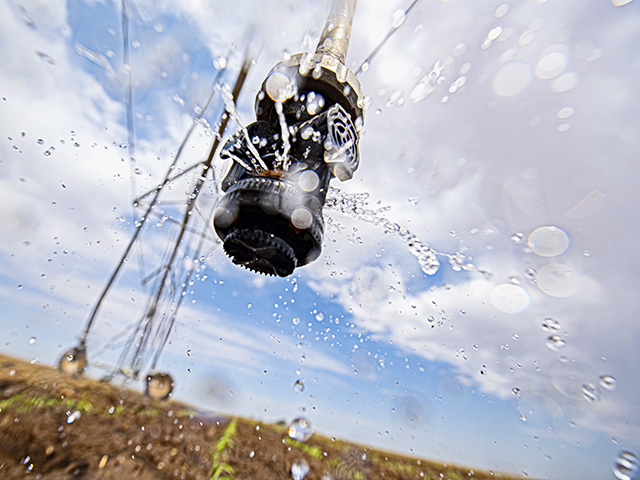Buying Time
Irrigation - Buying Time
Matt Moore was spraying wheat when one of his center-pivot sprinklers needed attention. "Instead of stopping what I was doing and driving 8 miles to the circle to turn off the pump, I just did it with my iPhone from the sprayer," the fourth-generation Texas Panhandle farmer explains. That call saved him 30 to 45 minutes in a place where constant wind leaves only short windows for spraying. Moore has been adding remote access to his irrigation system for several years.
Moore Family Farms, a 9,500-acre operation near Dalhart, Texas, is heavily involved in watermelon and pumpkin production, and has a busy rotation of traditional High Plains crops such as corn, cotton, milo and winter wheat. Half of the farm is in dryland production. Thirty-five sprinklers water the rest. The farm adjoins a 60,000-head feedlot, which provides a ready market for various chopped feeds and forage.
REMOTE ORGANIZATION
With the addition of two new sprinkler systems in the spring of 2020, Moore's inventory of pivots on the home farm includes 15 Reinke machines, all in the process of being equipped with ReinCloud Ag-Data Services and GPS service. The program enables growers to organize a farm by property, zones and equipment, and affords remote access to sprinkler operation and controls.
"The flexibility of the system allows us to tailor our watering to growing conditions, crop needs and sprinkler capabilities, and gives us remote access," Moore explains. "We have limited water on many of our circles, and to better manage the output of our wells, we can use the system to program barriers to water only partial sections or zones. For instance, on a half-mile sprinkler, which covers 500 acres, we have a 187-acre barrier set that allows us to efficiently water that zone for more water-thirsty crops.
"Cotton and melons work well together for us. If we have enough water to fully irrigate one circle, we'll plant one half in cotton and the other half in watermelons, and then alternate watering back and forth. That timing works well for us. Milo and cotton also work well together in the same way, and both will make a crop even if we lose water," he says.
P[L1] D[0x0] M[300x250] OOP[F] ADUNIT[] T[]
BOOST EFFICIENCY
"With sector programming, we can grow crops according to our water availability," Moore explains. "Also, we can fertigate partial portions of a circle depending on what we're growing, and we can start, stop and reverse the sprinklers at will remotely."
While meeting crop water and nutrient needs on an individual basis boosts farm efficiency, he says the biggest advantage of his irrigation management system is the conservation of personal time.
"I don't have to live worrying about, 'Did the pump come on?' Also, on high-value crops such as pumpkins, my crop adviser can tell me to start or stop, or reverse the sprinklers. I can do it from the tractor," Moore explains.
Despite a variety of crops growing and nearly three dozen sprinklers, he says he remains committed to "boots on the ground" when it comes to irrigation timing rather than using soil-moisture monitors.
"We've tried monitors, and for us, we just didn't see the advantage," he says. "The monitors provide information, but we've personally found it more effective to walk the fields with a 4-foot soil probe in hand. It seems more effective and efficient for us."
Moore's center pivots, pumping from as deep as 800 to 1,000 feet, generally are equipped with drops mounted 5 feet apart about 30 inches off the ground. Nelson "bubbler" nozzles fend off the evaporative effects of the nearly constant winds of the growing season.
"Over the past couple of years, we've made an effort with surface drip irrigation under plastic on our watermelons, but we've found the drops and bubbler nozzles are just as effective," Moore explains. "There's not a lot of wind loss with the bubblers."
COST CONTROL
Moore says sector control for fertigation is also a selling point for him.
"It's too early to pinpoint yield increases or fertilizer efficiency, but we know applying nitrogen through the sprinkler is dependable and saves the cost of an applicator," he says. "Also, we don't have to be there as it's being applied.
"Costwise, we've also found 32% liquid is less expensive than 46% dry fertilizer."
B.J. Ward, owner of Dalhart Alliance Irrigation, says Moore's adoption of remote-access irrigation technology is typical for High Plains agriculture, where water availability and the lack of labor are forcing growers to push for both agronomic and management efficiency.
"Matt's operation covers roughly 15 sections of land, and he and four employees are farming it," Ward says. "That's the shape of things to come in this part of the country. Adopting the latest technology is the only way to continue."
[PF_0820]
(c) Copyright 2020 DTN, LLC. All rights reserved.




